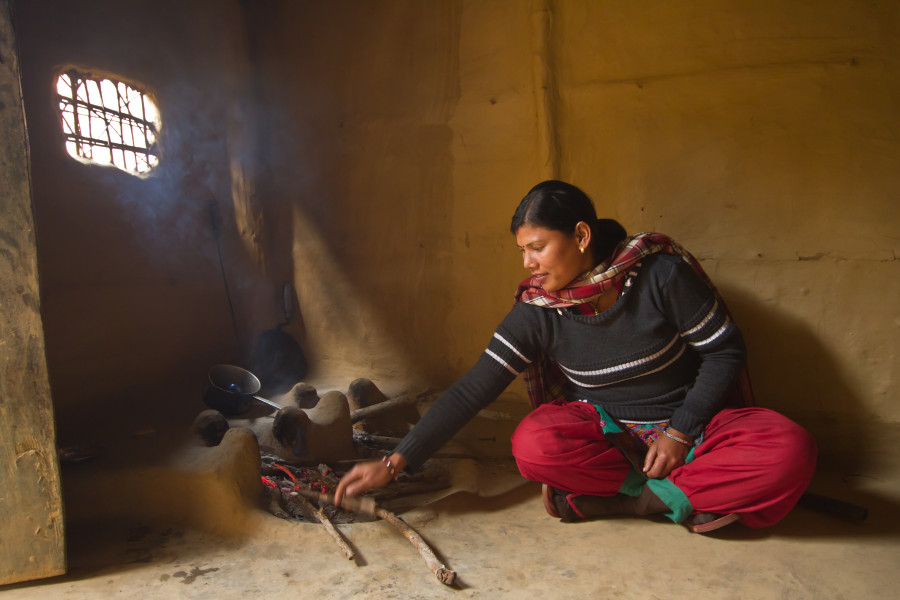Valley
Will Nepal be able to make households free from indoor air pollution?
Nepal is working to make all households free of indoor air pollution by 2022, a daunting task for the country which is highly dependent upon traditional biomass energy sources that include firewood, cattle dung, and agricultural residues.
Chandan Kumar Mandal
Nepal is working to make all households free of indoor air pollution by 2022, a daunting task for the country which is highly dependent upon traditional biomass energy sources that include firewood, cattle dung, and agricultural residues.
Various studies have projected alarming health impacts of indoor air pollution. Nearly 7,500 Nepalis die annually due to different diseases linked to indoor air pollution, like acute lower respiratory infection, chronic obstructive pulmonary disease, lung cancer (mainly due to coals), pulmonary tuberculosis, asthma and several cardiovascular disorders.
The Biomass Energy Strategy (2017), which mentions that nearly 77 percent of the country’s energy is supplied by traditional biomass energy, has envisioned making the country air pollution-free by 2022 through promotion of clean cooking technologies.
However, the country’s dependency on traditional biomass energy and fossil fuels has continued as ever before.
As reported by the Financial Survey 2017/18, for the first eight months, the total energy consumption is 9,019,400 tonnes of oil equivalents, with traditional energy, commercial energy (petroleum products, coal, LPG, electricity) and renewable energy (solar, biogas, mini and micro hydro, briquette) contributing 68.9 percent, 27.5 percent and 3.2 percent respectively.
According to Narayan Prasad Adhikari, director of the Head of Technology Division at the Alternative Energy Promotion Centre (AEPC), consumption of traditional biomass energy sources is not a problem in itself.
“Biomass energy sources have been used in other developed countries as well. The question is how we can consume them effectively and efficiently,”Adhikari told the Post.
The strategy aims to make efficient and effective utilisation of biomass energy to make indoor environment clean and to reduce dependency on fossil fuel by reducing consumption of LPG and kerosene and by promoting biodiesel/bioethanol to reduce petroleum products.
In reality, Nepal has spent a whopping Rs103 billion on fuel imports in the first six months of the current fiscal year.
According to Nepal Rastra Bank’s macroeconomic report, the country’s fuel import bill surged 50.4 percent year-on-year during the period of mid-July to mid-January, raising alarms that total import expenses may reach a staggering Rs200 billion if the same trend continues. This spending on fossil fuels looks alarming especially at the time households and industries having regular supplies.
Experts say while the complete shift towards clean energy is likely to take time as the share of electricity in total energy consumption is only about 4 percent and larger share is coming from traditional energy, simple and affordable measures like installing chimneys, improved cooking stoves and biogas pits can help address indoor air pollution.
Noting that 11 municipalities and 103 rural municipalities still do not have access to electricity from the national transmission grid, Adhikari said promotion of clean energy technologies can be an accessible measure to reduce household air pollution.
“Traditional cooking stoves consume excessive wood and emits more harmful smoke. Erecting chimneys and adopting clean energy technologies like improved cooking stoves (ICS), biogas, solar-cooker can help greatly in reducing household air pollution,” said Adhikari.
Two studies conducted by the AEPC have shown that the use of ICS can minimise indoor air pollution by 62 percent and reduce firewood consumption by 43 percent on average. Such technology also cuts down cooking time, meaning less exposure to smoke.
Women, children and elderly population as well as marginalised communities having limited access to clean energy sources are mostly affected by household pollution.
The Nepal Health Research Council study conducted in 600 households of the 20 erstwhile village development committees in Ilam district to measure indoor air pollution and its effects on human health revealed that children were at higher risk.
Nearly 10.4 percent of the children under 5 years of age had acute respiratory infections within last 2 weeks prior to the survey, 3.1 percent of the children reported wheezing during the last 12 months prior to the survey and 6.6 percent had never wheezed, according to the study.
Likewise, asthma like symptoms (wheezing, unremitting nocturnal cough and exercise induced cough) were reported among 4.1 percent of the children under 15 years of age during the last 12 months prior to the survey.
Energy expert Indira Shakya says the current status of energy consumption has led to gender-energy divide.
“Women are wasting their productive time collecting firewood, which otherwise would be utilised for income generations,”Shakya said. “In this gender-energy divide women not only collect and supply energy resources, but they also suffer health implications due to exposure to indoor air pollution.”
The country needs to promote modern renewable energy to save women from health hazards. However, renewable energy from solar, biogas, wind and off-grid micro hydropower make only 3 percent of the total energy consumption.
Increasing capacity of hydropower generation is seen as a positive stride towards encouraging shift from traditional fuels to electricity for daily energy needs and protecting citizens from household pollution.
“The country needs to speed up the implementation of hydro-based large scale projects as well as promote mini/micro hydropower throughout the country and develop solar/wind large scale projects to enhance its renewable energy sector,” Adhikari said. “Most of the electricity currently consumed is black electricity generated from coal. We don’t need electricity but clean electricity.”




 16.12°C Kathmandu
16.12°C Kathmandu










